When I heard about the death of Anthony Bourdain on June 8, I started grieving immediately. I did two things right away: I gathered all of his books that I already owned — I surrounded myself with them when I watched CNN’s tribute episode — and I got onto Amazon and ordered some of the rest. That’s when I discovered that he has a book coming out in October; I ordered that one, too.

This week, Anthony Bourdain’s Les Halles Cookbook finally arrived. It is my treasure. It is profound and profane, and the only cookbook I own (and I have dozens if not a couple hundred) that can make me laugh out loud, so hard it hurts. If you have a copy, you already understand. If you don’t have a copy, please find one. There must be a few more out there. As I read every word through page 043, I learned, I snorted, I thought, then I closed the book, held it to my chest, and smiled. Only for Tony would I conceive the foolhardy quest to cook my way through this book. (That’s why I’m only on page 043, having arrived at the first actual recipe.) But I’m sure that Tony, even after he rolled his eyes, would quietly be cheering me on as I started talking to butchers and grocers, venturing into the mercado for a key piece of equipment, and learning firsthand about System D.
I know that other home cooks have done similar things; I have read Julie & Julia with great delight. But all I have to do is scroll down (you can, too) to see what overambition can do to wear down a soul. For this “project” I have adopted no harsh-mistress timetable that will break me; I’ll just proceed through the recipes one at a time. I know that other people are cooking from — and blogging about — the recipes in this cookbook as a tribute or a way to grieve. If you’re one of them, I invite you to share your own experiences and thoughts as you wish, and share a beer with me.
So, here I go.
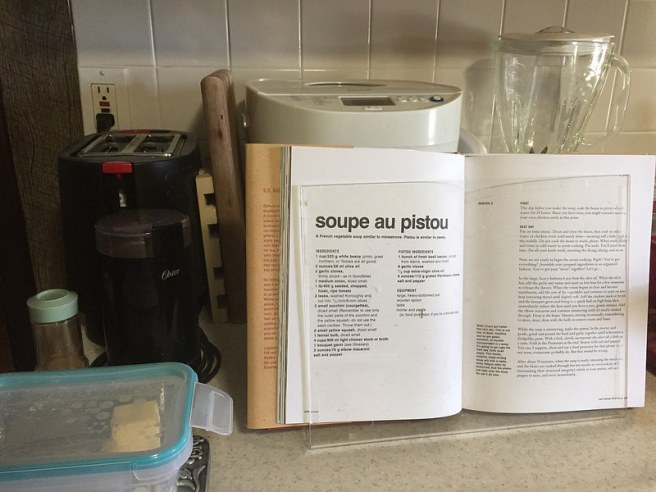
Soupe au pistou, Day One
Today’s tasks: rinse and soak the beans, make my own chicken stock, and find the ingredients I hadn’t already located (a bulb of fennel, more tomatoes, and a mortar and pestle).
I do not live in a major metropolitan area seasoned with specialty stores, but my area may turn out to have a few advantages. Nevertheless, fennel was tough to find at first. The condescending Walmart produce stocker I encountered on Friday afternoon had to backtrack when he heard what I was looking for, and admitted he’d never heard of such a thing. Saturday morning I decided to start at the Piggly Wiggly, just for the heck of it. There I scored their last bulb of fennel and four ripe-on-the-vine-they-were-still-attached-to tomatoes.

I knew that the mortar and pestle might be tricky to find locally; I had already done an Internet search and found a few sets forty minutes away at Target. In my two closest towns I went to three grocery stores, one farm-supply store, another Walmart, and three thrift stores before I remembered the Corelle/Corningware store at the outlet mall twenty miles to the north. Before I gave up and went there, I visited one more store: a Mexican grocery I had never entered before.
It was small, the aisles were narrow, the shelves were packed, and the meat counters had the most amazing beef and chicken and pork I have ever seen. Cookware and tools hung on the walls and were piled on top of refrigerator and freezer cases. After searching every aisle I still didn’t see a mortar and pestle, so I picked up a bag of Sabritas salt-and-lime peanuts and went to check out. I told the cashier I was looking for a mortar and pestle. No reaction. Molcajete? Confusion. I cupped my left hand and mimed grinding spices with my right. “I know we have one of those somewhere,” she said.
After several consultations with other employees and the use of a short stepladder, the cashier brought down my prize. Worried that its weight would tear through a single plastic grocery bag, she kindly triple-bagged it for me. ¡Muchas gracias! In the spirit of a tribute to all the hardworking Mexican cooks laboring in the restaurants of the United States, I’ll keep it in a place of honor and try to use it frequently. I think Tony would appreciate that I bought this one instead of something trendy, sophisticated, and undersized from Target.
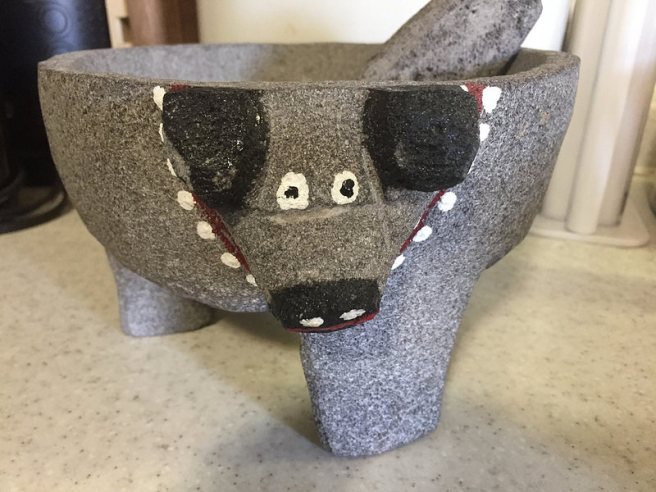
Back home again, I started the beans soaking and then prepared my ingredients for the chicken stock. I use a pretty standard recipe for chicken stock: a whole chicken, carrots, celery ribs, an onion, and 10 peppercorns. Today’s stockmaking session yielded about 10 cups of stock; tomorrow I’ll need 4 for the soup and more to cook the beans.

What did I learn today? Go to new places, speak up, and ask around. At the local meat market they didn’t have fennel and wouldn’t sell me chicken bones, but I found out that they’ll be able to sell me beef or pork bones when it’s time to make those kinds of stocks. Meat markets are big in Wisconsin, and so are home cooking, preserving, and canning. Basic supplies are all around — you just have to know where to look.
I also learned to check the inventory of what I “know” I already have. I was ready to add the onion to the simmering chicken stock-in-process when I realized that the four onions I had on hand were old and rotting. (Not only that, but when I took them to the trash can my grocery bag broke and spilled them on the kitchen floor.) I had to make another trip (fortunately, I found them locally) to get onions for the stock and tomorrow’s soup.

The beans are coming along.
Soupe au pistou, Day Two
I began the day by realizing that I will always be learning. I knew full well that the soup called for two ounces of olive oil and the pistou called for half a cup, and I also knew that I had olive oil in the cupboard — but I didn’t know how much I actually had. Sure enough, when I checked it I found about two ounces. I was going to have to make yet another trip to the grocery store. Some days I think that I will never stop learning.
While I was there I picked up a nicer looking onion, and a few more items for the rest of the week.
At noon I started to cook the beans. Tony cautions, repeatedly and emphatically, not to overcook the beans at this stage, as they will be “finished” in the soup.



While the beans cooled, I set out to create my mise en place. This also included hiking out into the garden to see if I could find zucchini and yellow squash in the “small” sizes called for; I was finally successful.
The beans finished cooking at about 12:30, and when a friend called me at 2:30 I was just getting ready to heat the olive oil and start tossing in the main ingredients. So yes, this took me longer to prepare than I had anticipated. But no, you couldn’t prepare this recipe any other way than to do all the chopping in advance.

The recipe itself is succinct. I, however, had questions and obvious shortcomings. Cut the fennel into 1/4-inch slices? Sure! Wait a minute, did you mean sticks or half-circles or…oh, what the heck, I’ll do rings. And my knife skills began at “pathetic” and gradually worked their way up to “perhaps not horribly embarrassing.” I’m sure that I’ll get better with practice: lots and lots of practice. And a sharper knife.
Here is how everything came together:




While the soup simmered away, with dry macaroni and mostly-cooked beans to be added a few minutes later, I gathered the ingredients for the pistou, or basil and cheese paste. This subprocess was the reason for my Great Mortar and Pestle Search of yesterday. It really was amazing the way a great volume of ingredients was reduced to a paste. I wish I did have some photos of the new equipment in action, but I was busy acting quickly as the soup simmered faster and faster behind my back.
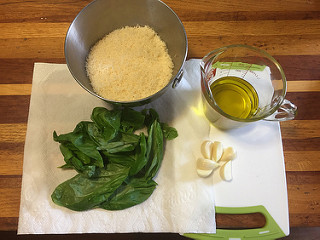
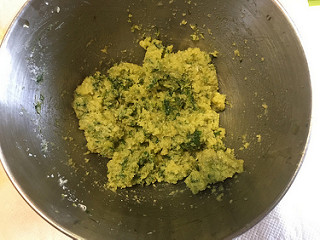
At some point I was concerned that there was not enough broth in the soup to finish cooking the beans. I removed the bouquet garni and hoped it would give the beans a bit more room.
The main problem with the beans was that I had kept them far too undercooked at the previous stage. Though I shared Tony’s concern about overcooking, I didn’t have enough experience with cooking beans to have any idea how long it would take to produce fully cooked beans. As a result, even by the end of the dish the beans still weren’t quite cooked enough. With more practice, that problem should solve itself.
When I couldn’t take it any longer I stirred in the pistou, added salt and pepper, and served myself a bowl. (Okay, two bowls.)

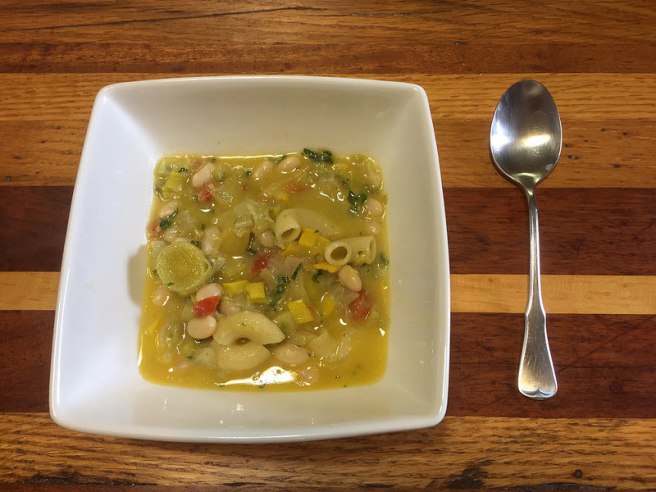
I now have 8-9 cups of tasty soup to freeze or pass along to a tolerant friend. And I learned a lot.
The next recipe, whenever I’m ready for it, is Onion Soup Les Halles. It calls for port, which I don’t have on hand; a quarter pound of slab bacon, a potential issue since I am still eating Kosher; 12 ounces of authentic Gruyère, possibly difficult to find in this area; and 8 ovenproof soup crocks, necessitating (twist my arm!) a trip to a restaurant supply store. Thankfully, the propane torch is described as “optional.”
